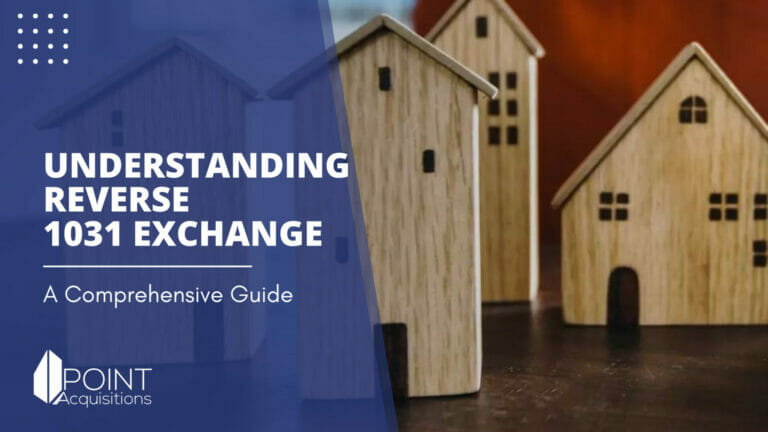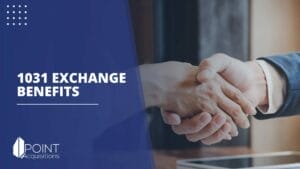
Reverse 1031 Exchange: What It Is and How It Works
A 1031 exchange is a powerful tool for wealth preservation and growth by offering investors a unique opportunity to defer capital gains taxes and unlock the full potential of their real estate investments.
While many individuals are familiar with the conventional forward 1031 exchange, a lesser-known but increasingly intriguing option has piqued savvy investors’ interest: the reverse 1031 exchange.
In this alternative approach to tax-deferred real estate transactions, the sequence is reversed, prompting investors to sell or acquire properties in a manner that might seem counterintuitive at first glance.
In this article, we delve into the intricacies of the 1031 reverse exchange rules, shedding light on what it is and how it works, unveiling a powerful tool for investors seeking to optimize their real estate portfolios while deferring capital gains taxes.

Table of Contents
What is a Reverse 1031 Exchange?
A 1031 reverse exchange is a smart tax strategy for real estate investors. With a reverse exchange, you can buy a new property now and wait to sell another one later, potentially getting a better price. This gives you more flexibility to adapt to changes in the real estate market and improve your investment position.
This type of exchange follows certain rules, mainly in Revenue Procedure 2000-37. This guideline has become popular because it provides clear steps and protections for investors. Even though people have been doing reverse exchanges for a while, following this procedure ensures things go smoothly and according to the law. And just like a regular 1031 exchange, there’s a specific timeline you need to follow for a reverse exchange to make sure you get all the tax benefits while staying within the rules.
This may sound simple, but much attention to detail and meticulous planning is required.

What do I need to consider when doing a Reverse 1031 Exchange?
1031 reverse exchanges are far from a straightforward process due to their intricacies. These transactions involve meticulously orchestrating property ownership, funds, and timelines, necessitating careful planning and compliance with complex tax regulations. Potential investors will need to first consider the following:
Funding
Investors must approach funding carefully before embarking on a 1031 reverse exchange. Unlike a standard exchange, in a reverse exchange, the exchangor must possess the financial ability to purchase the replacement property without relying on sale or exchange proceeds.
This necessitates tapping into other financial resources or securing a loan from a commercial lender, making prudent financial planning and access to capital imperative for a successful transaction.
Parking
Conducting a 1031 reverse exchange introduces the concept of parking. In this process, the exchangor is prohibited from simultaneously holding the title to both properties.
An Exchange Accommodation Titleholder (EAT) is established to navigate this restriction, holding or parking the title to either the old or new property. Deciding which property to park hinges on factors such as the source of funds, existing liens, and equity.
Importantly, if the exchangor plans to make improvements, the replacement property must be parked, with all enhancements completed before taking possession. Regardless of the property parked, it remains accessible to the exchangor throughout the exchange.

What are the steps of a Reverse 1031 Exchange?
A 1031 reverse exchange requires investors to navigate a precise choreography of steps to maximize its benefits while ensuring compliance with tax regulations. a reverse 1031 exchange is typically completed in six steps:

Step 1: Identify an exchange accommodator
The initial crucial step in a 1031 reverse exchange is identifying an Exchange Accommodator Titleholder (EAT). The EAT plays a pivotal role by temporarily holding the title to the replacement property until the exchange concludes.
This arrangement is formalized through a Qualified Exchange Accommodation Agreement (QEAA) between the exchangor and the EAT. Selecting a reliable EAT is paramount, as they act as a custodian for the replacement property, ensuring compliance with IRS regulations and enabling the investor to navigate the particulars of the reverse exchange process with confidence.

Step 2: Buy the property
In the second step of a 1031 reverse exchange, the exchangor proceeds to purchase their replacement property. This property can encompass various types as long as they qualify for a like-kind properties 1031 exchange per IRS guidelines.
Crucially, the replacement property must hold an equal or greater value than the relinquished property to ensure full tax deferral benefits. In some cases, the exchangor may collaborate with a lender to secure financing for at least a portion of the property’s purchase price, allowing them to acquire a suitable replacement asset while maintaining the tax-deferral advantage.

Step 3: Transfer replacement property title to EAT
During step 3 of a 1031 reverse exchange, following the closure of the purchase transaction, the Exchange Accommodator Titleholder assumes possession of the title to the newly acquired property. This transfer of property title to the EAT aligns with the terms outlined in the Qualified Exchange Accommodation Agreement.
The EAT will safeguard the property title until the exchange process concludes, ensuring compliance with IRS regulations and providing the necessary framework for a successful reverse exchange.

Step 4: Identify relinquished property
Step 4 in a 1031 reverse exchange is a critical stage where the investor determines which property they intend to sell if they own multiple properties.
This identification must be formalized in writing within 45 days of purchasing the replacement property, according to the 1031 exchange 45 day rule. Careful selection of the relinquished property is vital, as it dictates which asset will eventually be sold to complete the exchange. 1031 exchange identification rules generally require precise timing, assertive decision-making, and meticulous documentation.

Step 5: Choose a Qualified Intermediary
Choosing a Qualified Intermediary (QI) is paramount before moving toward the final step. A QI is an expert well-versed in the intricate rules of 1031 exchanges and is pivotal in ensuring compliance throughout the exchange process.
The selection of a reputable QI is a crucial decision, as they help safeguard the transaction from disqualification by facilitating the transfer of funds, ensuring adherence to IRS regulations, and attentively handling the specifics of the exchange. The expertise and diligence of the QI are essential factors that can significantly impact the success of the reverse exchange.

Step 6: Sell The Relinquished Property
The final step of a 1031 reverse exchange involves selling the relinquished property adhering to the 1031 exchange 180 day rule, essentially within 180 days of acquiring the replacement property. During this phase, the investor must complete the remaining exchange work, including transferring the title and executing the final exchange details.
This step finalizes the exchange process, allowing the investor to fulfill the requirements of the reverse exchange while deferring capital gains taxes. It’s the culmination of careful planning, coordination, and adherence to IRS regulations, ultimately providing investors with the desired tax benefits and optimized real estate investment positions.

What are the rules of a Reverse 1031 Exchange?
For a successful 1031 reverse exchange, several crucial rules must be observed. First, it follows the same principles as forward 1031 exchanges, where the old property must be sold before acquiring the new one. This process should be completed within 180 calendar days from the initial closing of the replacement property.
Additionally, the entity or individual selling the old property must be the same entity or individual buying the new property. Rules related to transactions with related parties and disqualified persons apply, and the value of the replacement property must equal or exceed that of the relinquished property to avoid triggering taxes on the difference.
Finally, neither the relinquished property nor the replacement can serve as the taxpayer’s primary residence for these rules to apply effectively.

Potential Challenges of a Reverse 1031 Exchange
Several challenging issues come into play with a 1031 reverse exchange. Firstly, securing a loan can be daunting in a tight credit market, potentially complicating financing.
Moreover, owning two properties is risky if the old one doesn’t sell within the mandated 180-day timeframe.
Transfer taxes can also be a concern, with some states recognizing the EAT’s role as an agent and exempting taxes, while others may not. Assigning membership interest in the EAT can potentially be a strategy to avoid transfer taxes.
Additionally, varying state rules necessitate a deep understanding from the Qualified Intermediary, adding to the complexity.
Lastly, the overall cost of a reverse 1031 exchange tends to be higher due to its specific nature and standard state fees.

Why would I Consider a Reverse 1031 Exchange?
The benefits of a 1031 reverse exchange for potential investors are evident, especially when finding a suitable replacement property within the mandated time frame proves challenging.
This strategy is particularly advantageous when an investor comes across their desired replacement property before selling the old one. Reversing the typical 1031 exchange sequence offers flexibility and minimizes the risk of losing out on a valuable investment opportunity. This allows investors to optimize their real estate portfolios while deferring capital gains taxes.
Interested In learning more?
Ready to explore the world of 1031 exchanges with experts? Contact Point Acquisitions today for in-depth insights and guidance from our seasoned professionals. Unlock the benefits of tax-deferred real estate investments now!
About The Author

Jesse Shemesh
Disclaimer
Please note that Point Acquisitions is not a tax expert or tax advisor. The information on our blogs and pages is for general informational purposes only and should not be relied upon as legal, tax, or accounting advice. Any information provided does not constitute professional advice or create an attorney-client or any other professional relationship. We recommend that you consult with your tax advisor or seek professional advice before making any decisions based on the information provided on our blogs and pages. Point Acquisitions is not responsible for any actions taken based on the information provided on our blogs and pages.
1031 Exchange Capital Gains Tax Deferral
According to a 2021 report by the National Real Estate Exchange Services (RES), over 240,000 1031 exchange transactions were completed in the United States, totaling $100 billion. This impressive figure underscores the role of 1031 exchanges in the real estate…
Read More1031 Exchange Benefits
As of Q4 2023, the national vacancy rate for all commercial property types in the United States sat at 9.2%, according to CBRE’s latest insights and research. This represents a slight decrease compared to the previous quarter and suggests a…
Read More1031 Exchange Legal Considerations: A Must-Read Guide
You’re in the right place if you’re considering a 1031 exchange for your commercial real estate investments. Whether you’re a seasoned investor or just dipping your toes into the market, understanding the legal landscape of 1031 exchanges is key to…
Read More

